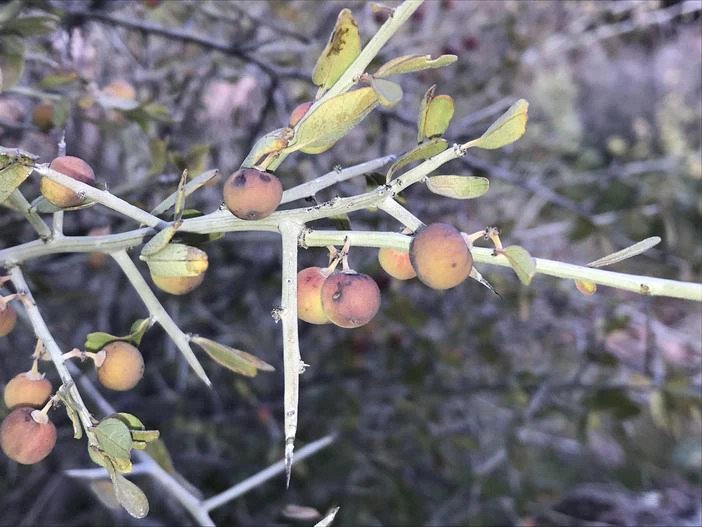Lotebush
(Sarcomphalus obtusifolius var. canescens)
Lotebush (Sarcomphalus obtusifolius var. canescens)
/
/

Robb Hannawacker
CC0
Image By:
Robb Hannawacker
Recorded By:
Copyright:
CC0
Copyright Notice:
Photo by: Robb Hannawacker | License Type: CC0 | License URL: http://creativecommons.org/publicdomain/zero/1.0/deed.en | Uploader: Loopy30 | Publisher: Wikipedia Commons



Estimated Native Range
Climate Requirements for Burleson, Texas
| This Plant | Your Site | Plant Suitability for Your Location | ||
|---|---|---|---|---|
| • Precipitation | 2" - 33" | 34" | Your precipitation may be too high for this plant. | Too high |
| • High Temp. | 87°F - 111°F | 96°F | Your summer temperatures are normal for this plant. | Excellent |
| • Low Temp. | 27°F - 55°F | 33°F | Your winter temperatures are normal for this plant | Excellent |
This plant may not grow well at your location - your precipitation is too high.
Summary
Sarcomphalus obtusifolius var. canescens, commonly known as the Lotebush, is a thorny shrub native to the Southwestern US and Northern Mexico. It typically reaches a height of 8-15 feet and 2-4 feet of similar spread, and has a dense, rounded crown. It is a deciduous shrub with a somewhat grayish-white appearance due to the characteristic canescence on its stems and leaves. It produces small, inconspicuous flowers and small, dark, berry-like fruits.
It is valued for its hardiness and drought tolerance, making it suitable for xeriscaping and as a windbreak in coastal areas. It is also used for reforestation projects due to its adaptability to poor soils. In cultivation, it requires well-drained soil, thrives in full sun to partial shade, and once established, has low water needs. There are no widely known cultivars of this variety. Gardeners should be aware that the tree can suffer from root rot if overwatered and may be susceptible to pests such as scales and mites.CC BY-SA 4.0
It is valued for its hardiness and drought tolerance, making it suitable for xeriscaping and as a windbreak in coastal areas. It is also used for reforestation projects due to its adaptability to poor soils. In cultivation, it requires well-drained soil, thrives in full sun to partial shade, and once established, has low water needs. There are no widely known cultivars of this variety. Gardeners should be aware that the tree can suffer from root rot if overwatered and may be susceptible to pests such as scales and mites.CC BY-SA 4.0
Plant Description
- Plant Type: Shrubs
- Height: 8-15 feet
- Width: 2-4 feet
- Growth Rate: Slow
- Flower Color: Yellow
- Flowering Season: Spring, Summer
- Leaf Retention: Deciduous
Growth Requirements
- Sun: Full Sun, Part Shade
- Water: Medium
- Drainage: Medium
Common Uses
Bee Garden, Butterfly Garden, Edible*Disclaimer: Easyscape's listed plant edibility is for informational use. Always verify the safety and proper identification of any plant before consumption., Low Maintenance, Potted Plant
Natural Habitat
occurring on mesas, canyon slopes, and in desert grasslands in the Southwestern US and Northern Mexico
Other Names
Common Names: Clepe
Scientific Names: Sarcomphalus obtusifolius var. canescens , Condalia divaricata , Condalia lycioides var. canescens , Condaliopsis lycioides var. canescens , Ziziphus divaricata , Ziziphus lycioides var. canescens , Ziziphus obtusifolia var. canescens
GBIF Accepted Name: Sarcomphalus obtusifolius var. canescens